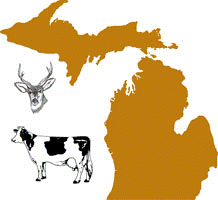Wildlife Disease and Zoonotics
Date of this Version
2004
Abstract
Tuberculosis due to Mycobacterium bovis in captive Cervidae was identified as an important disease in the United States in 1990 and prompted the addition of captive Cervidae to the USDA Uniform Methods and Rules for eradication of bovine tuberculosis. As well, M. bovis infection was identified in free-ranging white-tailed deer in northeast Michigan in 1995. Tuberculosis in both captive and free-ranging Cervidae represents a serious challenge to the eradication of M. bovis infection from the United States. Currently, the only approved antemortem tests for tuberculosis in Cervidae are the intradermal tuberculin skin test and the blood tuberculosis test (BTB). At present, the BTB is not available in North America. Tuberculin skin testing of Cervidae is time-consuming and involves repeated animal handling and risk of injury to animals and humans. This study evaluated the potential of a new blood-based assay for tuberculosis in Cervidae that would decrease animal handling, stress, and losses due to injury. In addition, a blood-based assay could provide a more rapid diagnosis. Twenty 6–9-month-old white-tailed deer, male and female, were experimentally inoculated by instillation of 300 colony-forming units of M. bovis in the tonsillar crypts. Seven, age-matched uninfected deer served as controls. Blood was collected on days 90, 126, 158, 180, 210, 238, 263, and 307 after inoculation and was analyzed for the production of interferon-γ (IFN-γ) in response to incubation with M. bovis purified protein derivative (PPDb), M. avium PPDa, pokeweed mitogen (PWM), or media alone. Production of IFN-g in response to PPDb was significantly greater (P < 0.05) at all time points in samples from M. bovis–infected deer as compared with uninfected control deer, whereas IFN-γ production to PWM did not differ significantly between infected and control deer. Measurement of IFN-γ production to PPDb may serve as a useful assay for the antemortem diagnosis of tuberculosis in Cervidae.



Comments
Published in J Vet Diagn Invest 16:17–21 (2004).